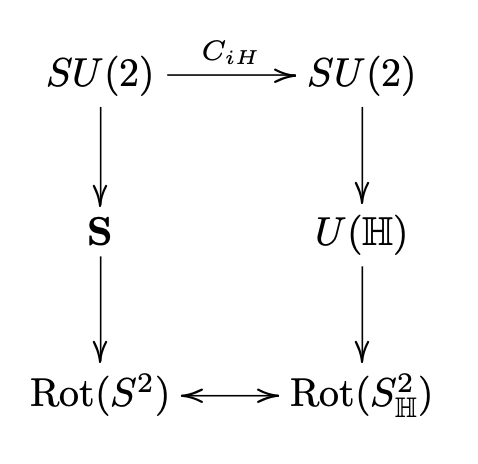3.6: Additional exercises
( \newcommand{\kernel}{\mathrm{null}\,}\)
Exercises
Exercise 1
Euclidean subgroup of the Möbius group.
Let E denote the subgroup of the Möbius group M generated by rotations and translations, that is, transformations of the type z→eitz for t∈R and z→z+b for b∈C. The geometry (C,E) is sometimes called "Euclidean geometry". Is (C,E) equivalent to the Euclidean geometry defined in Subsection 3.1.1? Why or why not?
Exercise 2
Elliptic geometry and spherical geometry.
Is elliptic geometry (ˆC,S) equivalent to spherical geometry defined in Subsection 3.1.1? Why or why not?
Exercise 3
Parallel displacements in hyperbolic geometry.
Let T be an element of the hyperbolic group H, with a single fixed point p and normal form
1Tz−p=11−p+β.
Show that pβ must be a pure imaginary number, that is, there must be a real number k such that pβ=ki.
Exercise 4
Prove that all elements of the elliptic group S are elliptic in the normal form sense, i.e., we have |α|=1 in the normal form expression
Tz−pTz−q=αz−pz−q.
Suggestion: First find the fixed points p,q, then put z=∞ in the normal form equation and solve for α.
Exercise 5
Alternative derivation of the formula for elliptic group elements.
To obtain an explicit formula for elements of the elliptic group, we begin with a necessary condition. Let R=s−1∘T∘s be the rotation of S2 that lifts T via stereographic projection. If P,Q are a pair of endpoints of a diameter of S2, then R(P),R(Q) must also be a pair of endpoints of a diameter. Exercise 1.3.3.7 establishes the condition that two complex numbers p,q are stereographic projections of endpoints of a diameter if and only if pq∗=−1. Thus we have the following necessary condition for T.
pq∗=−1 implies Tp(Tq)∗=−1
Now suppose that Tz=az+bcz+d with ad−bc=1. Solving the equation Tp=−1(T(−1p∗))∗ leads to c=−b∗ and d=a∗. Thus we conclude that T has the following form.
Tz=az+b−b∗z+a∗,|a|2+|b|2=1
Carry out the computation to derive (3.6.2). Explain why there is no loss of generality by assuming ad−bc=1.
Exercise 6
Identifications of U(H) and S with Rot(S2).
The discussion of elliptic geometry (Section 3.4) establishes two ways to construct rotations from matrices. The purpose of this exercise is to reconcile these identifications. Given a,b∈C with |a|2+|b|2=1, let us define the following objects, all parameterized by a,b.
Ma,b=[ab−b∗a∗]ra,b=Re(a)+Im(a)i+Re(b)j+Im(b)kRra,b=[u→ra,bur∗a,b]for u∈S2HTa,b=[z→az+b−b∗z+a∗]for z∈ˆCRTa,b=s−1∘Ta,b∘s
The above objects are organized along two sequences of mappings. The rotation Rra,b is at the end of the "quaternion path"
SU(2)→U(H)→Rot(S2H)Ma,b→ra,b→Rra,b
and the rotation RTa,b is at the end of the "Möbius path"
SU(2)→§→Rot(S2)Ma,b→Ta,b→RTa,b.
This problem is about comparing the rotations Rra,b and RTa,b (see Table 3.6.1) and reconciling the difference. The angles of rotation are the same, but the axes are different, but only by a reordering of coordinates and a minus sign.
| Rv,θ | axis of rotation v | angle of rotation θ |
| Rra,b | (Im(a),Re(b),Im(b))√1−(Re(a))2 | 2arccos(Re(a)) |
| RTa,b | (Im(b),−Re(b),Im(a))√1−(Re(a))2 | 2arccos(Re(a)) |
The exercises outlined below verify the values for v,θ in Table 3.6.1.
- Use Proposition 1.2.9 to justify the values for v and θ for Rra,b in Table 3.6.1.
- Solve Ta,bz=z to show that one of the fixed points of Ta,b is
p=−ib(√1−(Re(a))2+Im(a)|b|2).
- Show that s((Im(b),−Re(b),Im(a))√1−(Re(a))2)=p.
- Show that
Ta,b=s∘h∘Rra,b∘h∘s−1
where h:R3→R3 is given by (x,y,z)→(z,−y,z). Here's one way to do this: evaluate both sides of (3.6.5) on the three points p,0,∞. Explain why this is sufficient! Use quaternion multiplication to evaluate Rra,b. For example, Rra,b(1,0,0)=ra,bir∗a,b under the natural identification R3↔R3H. - Here is one way to reconcile the quaternion path (3.6.3) with the Möbius path (3.6.4). Let H=1√2[111−1] (the matrix H is sometimes called the Hadamard matrix) and let CiH denote the map M→(iH)M(iH)−1. Show that the diagram in Figure 3.6.2 commutes. Hint: Notice that iH∈SU(2) and that Q(iH)=1√2(i+k), and that RQ(iH)=h.


Exercise 7
Pythagorean Theorems.
Let △ABC be a right triangle with right angle ∠C with side lengths a=d(B,C), b=d(A,C), and c=d(A,B) so that the length of the hypotenuse is c. See Figure 3.6.3.
- Prove the following identities.
cosh(ln(1+u1−u))=1+u21−u2(0<u<1)cos(2arctanu)=1−u21+u2
- The Hyperbolic Pythagorean Theorem. Show that
cosh(c)=cosh(a)cosh(b)
if T is a hyperbolic triangle. - The Elliptic Pythagorean Theorem. Show that
cos(c)=cos(a)cos(b)
if T is an elliptic triangle.
Suggestion: Use a transformation to place C at 0 in D or ˆC, with A is real and B pure imaginary. Use the formula d(p,q)=ln((1+u)/(1−u)) with u=|q−p1−p∗q| for hyperbolic distance. Use the formula d(p,q)=2arctan(u), with u=|q−p1+p∗q| for elliptic distance. The identities from part (a) will be useful.


